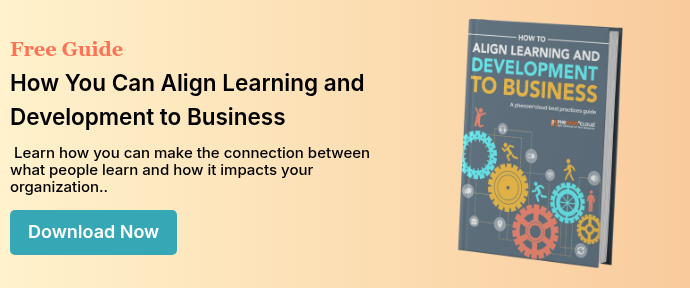
Choosing a Learning Management System for your company can be overwhelming. There are over 400 LMS vendors in the market, and each one has its strengths and shortcomings.
There is no “best” Learning Management System, but there is the right one for you. Following the steps outlined below, you can take charge of the process to find the ideal solution for your company.
Align Your Project with Your Purpose
Before you begin, stop to think about your learning project in the larger context of your culture, purpose, and strategy – who you are as a company, where you are going, and how you will get there. Here is a sample list of questions to get you started.
- What you need to do to meet your current challenges?
- What will your workforce need to be in one year? Two years? Three years?
- Is your workforce engaged and aligned with your mission? If not, you may want to seize this opportunity use your learning management system as a transformational tool. Your LMS will touch everyone, so using it in a change communication strategy can improve your results.
- Are any organizational changes coming? Mergers or acquisitions? What is your strategy for assimilation and how will you use your LMS to support it?
- What type of learning system will you need? A learning management system? A learning experience system? Both LMS and LXP?
Assess the Current System
Ask your stakeholders where your current system is falling short of your needs. Ask the people in your audiences, LMS, and learning development teams what is making things difficult for them. Asking the question will sow seeds of dissatisfaction with your current system. You can leverage the dissatisfaction to help motivate your stakeholders to support the change.
Be as detailed as possible. Your findings will help in your needs assessment.
Assess Learning Needs
Consider both your current and future needs. For example, if you do not currently use a mobile platform but plan to in the future, you will want to think about choosing a provider who can enable mobile when you need it.
Here are some things to consider:
- What audiences do you serve? Employees, contingent workers, extended enterprise, partners, customers?
- What type of learning activities will you need to deploy? You may be considering moving from asynchronous to synchronous learning, or using more just in time video learning.
- Do you need an ecommerce solution? Will it be public or private?
- What content integration standards do you require? AICC/SCORM[JM2] , Tin Can/Experience API, or custom solutions?
- Will you need to migrate learning content, activity registrations, and completions from your current system?
Assess Your Limitations
Assessing the capability and technical limitations of your users will help you determine your needs.
- Whether you will need to improve the skills of your curriculum development staff, and how much of your content you will need to outsource.
- The level of support you will need for your audiences. If you have expert resources, your staff may be able to handle user support. If not, implementation partners will offer several support levels from an occasional help call to complete managed services.
- The capability of your administrative staff. Balance the features you need with what your people can handle. You may need ongoing support. If your team doesn't have the skills, consider engaging an application management service to handle administration for you.
Scan for Solutions
At this point, you will be learning what is possible rather than which vendor you will choose. If you have not already done so, use industry knowledge sources, such as Gartner, Chief Learning Officer, eLearning Industry, Bersin, and the Institute for Corporate Productivity. You will find exhaustive lists of features and discussions of technology delivery models, and will avoid the hype on individual vendor websites.
Here are some things to consider:
- Some companies use purchased on-premises systems, but the current trend in the industry is toward cloud solutions. Cloud providers that continuously improve with updates and almost always included in a subscription. The one-time price of a purchased solution may seem attractive, but consider the cost of future upgrades and the risk of obsolescence before you make the decision.
- It’s important for a solution to meet your needs, but be wary of customizations that will make upgrades difficult and expensive. You may be better off if you tweak your processes rather than spending on customization.
- What are your reporting needs? According to a Chief Learning Officer, 2014 survey, only 33.7 percent of respondents were satisfied with the analytics capabilities of their current systems. Seek vendors who can help you correlate learning with business results for useful intelligence.
Launch Your RFP
Make your Request for Proposal as detailed as possible to enable software vendors to answer your specific needs. Don't include your priorities, so you don’t skew the responses. You may want to allow for some flexibility in your proposal to allow responders to explain how they will meet your requirements. They may present a solution you haven’t considered.
You will need an evaluation matrix to score responses to your RFP. If you have an experienced RFP team, they can guide you. If not, you might want to invest in RFP software. The software service Capterra has a long list of RFP solutions. Ask people in your network what works for them and scan your social networks.
Use the evaluation matrix to narrow your field of contenders. Keep your list small so you can spend more time on the steps that follow.
Eliminate proposals that don’t fit your budget. Providers use different price models. Some price by the number of registered users and some by the number of users logged into the application over a period, usually a month. Base your decision on the total cost of ownership over several years. Some vendors have higher up-front implementation cost. Others build some of it into the subscription price.
Talk with Your Candidates
By now, your list of vendors should be very short. Contact the top contenders and talk with them about your needs. Your purpose on the call is to determine if you want to work with them. You will work closely together for a very long time, and relationships are important. If they listen closely to your needs, keep them on your list. During the call, speak to each of your requirements and note how they respond. Don’t agree to a demo until after you complete the next step.
Investigate Your Candidates
Investigate the experience, financial stability, and customer satisfaction of each of the remaining providers on your shortlist.
- Years of experience and the number of successful projects in your industry are important, but you may want to pay attention to whether the vendor has become complacent in its success. Frequently a rising star will try harder to satisfy you. People do change jobs, or a relatively new company may have very experienced people.
- You might want to go beyond the financial data in the RFP response. Asking customers about stability can help, and you can scan industry news to see what is there. Ask for references.
- The best providers will be happy to cooperate with you, and will want you to talk directly with their customers.
Get to Know the Products
By now, your list should be short enough to make demos manageable. Don’t hesitate to ask for a free trial or a “sandbox,” to get a hands-on look at the solution. The best vendors will pre-configure their demos to demonstrate how their product meets your needs.
Choose the Right Implementation Partner
Still overwhelmed? An independent implementation partner will be able to ensure your success. Choose your implementation partner carefully. The right partner is as important as the software solution.
We hope these steps will help you in finding right learning platform for your business.
Additional Sources
Bersin, Josh. “The LMS Market: Hotter than Ever.” Josh Bersin Company, February 14, 2022. https://jbc.joshbersin.com/the-lms-market-hotter-than-ever/.
Krishnan, Balasubramanian. “Your Guide for Choosing a Learning Platform That Demonstrates Learning Outcomes.” eLearning Industry, March 17, 2022. https://elearningindustry.com/your-guide-for-choosing-a-learning-platform-that-demonstrates-learning-outcomes.
Weiss, Craig. “Learning System Buyer's Guide.” By Craig Weiss, September 22, 2022. https://elearninfo247.com/2022/01/20/learning-system-buyers-guide/.
PhenomᵉCloud is a vendor-agnostic learning consulting company. Our mission is to implement the solution that will meet your needs and grow with you to help your workforce drive business results.
Contact us today or call 1-855-978-6816 to talk with us about your learning needs.

Leave a Comment